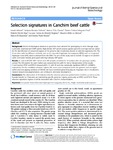Por favor, use este identificador para citar o enlazar este ítem:
http://www.alice.cnptia.embrapa.br/alice/handle/doc/1061492Registro completo de metadatos
| Campo DC | Valor | Lengua/Idioma |
|---|---|---|
| dc.contributor.author | URBINATI, I. | pt_BR |
| dc.contributor.author | STAFUZZA, N. B. | pt_BR |
| dc.contributor.author | OLIVEIRA, M. T. | pt_BR |
| dc.contributor.author | CHUD, T. C. S. | pt_BR |
| dc.contributor.author | HIGA, R. H. | pt_BR |
| dc.contributor.author | REGITANO, L. C. de A. | pt_BR |
| dc.contributor.author | ALENCAR, M. M. de | pt_BR |
| dc.contributor.author | BUZANSKAS, M. E. | pt_BR |
| dc.contributor.author | MUNARI, D. P. | pt_BR |
| dc.date.accessioned | 2017-01-23T11:11:11Z | pt_BR |
| dc.date.available | 2017-01-23T11:11:11Z | pt_BR |
| dc.date.created | 2017-01-23 | pt_BR |
| dc.date.issued | 2016 | pt_BR |
| dc.identifier.citation | Journal of Animal Science and Biotechnology, v. 7, p. 1-9, 2016. | pt_BR |
| dc.identifier.uri | http://www.alice.cnptia.embrapa.br/alice/handle/doc/1061492 | pt_BR |
| dc.description | Background: Recent technological advances in genomics have allowed the genotyping of cattle through single nucleotide polymorphism (SNP) panels. High-density SNP panels possess greater genome coverage and are useful for the identification of conserved regions of the genome due to selection, known as selection signatures (SS). The SS are detectable by different methods, such as the extended haplotype homozygosity (EHH); and the integrated haplotype score (iHS), which is derived from the EHH. The aim of this study was to identify SS regions in Canchim cattle (composite breed), genotyped with high-density SNP panel. Results: A total of 687,655 SNP markers and 396 samples remained for SS analysis after the genotype quality control. The iHS statistic for each marker was transformed into piHS for better interpretation of the results. Chromosomes BTA5 and BTA14 showed piHS>5, with 39 and nine statistically significant SNPs (P<0.00001), respectively. For the candidate selection regions, iHS values were computed across the genome and averaged within non-overlapping windows of 500 Kb. We have identified genes that play an important role in metabolism, melanin biosynthesis (pigmentation), and embryonic and bone development. Conclusions: The observation of SS indicates that the selection processes performed in Canchim, as well as in the founder breeds (i.e. Charolais), are maintaining specific genomic regions, particularly on BTA5 and BTA14. These selection signatures regions could be associated with Canchim characterization. | pt_BR |
| dc.language.iso | eng | eng |
| dc.rights | openAccess | eng |
| dc.subject | Genômica | pt_BR |
| dc.subject | Polimorfismo de nucleotídeo único | pt_BR |
| dc.subject | Extended haplotype homozygosity | pt_BR |
| dc.title | Selection signatures in Canchim beef cattle. | pt_BR |
| dc.type | Artigo de periódico | pt_BR |
| dc.date.updated | 2017-03-20T11:11:11Z | pt_BR |
| dc.subject.thesagro | Gado de corte | pt_BR |
| dc.subject.nalthesaurus | Composite breeds | pt_BR |
| dc.subject.nalthesaurus | Genomics | pt_BR |
| dc.subject.nalthesaurus | Single nucleotide polymorphism | pt_BR |
| dc.subject.nalthesaurus | Beef cattle | pt_BR |
| dc.subject.nalthesaurus | Quantitative trait loci | pt_BR |
| dc.description.notes | Na publicação: Luciana Correia de Almeida Regitano. | pt_BR |
| riaa.ainfo.id | 1061492 | pt_BR |
| riaa.ainfo.lastupdate | 2017-03-20 | pt_BR |
| dc.identifier.doi | 10.1186/s40104-016-0089-5 | pt_BR |
| dc.contributor.institution | ISMAEL URBINATI, Unesp Jaboticabal; NEDENIA BONVINO STAFUZZA, Unesp Jaboticabal; MARCOS TÚLIO OLIVEIRA, Unesp Jaboticabal; TATIANE CRISTINA SELEGUIM CHUD, Unesp Jaboticabal; ROBERTO HIROSHI HIGA, CNPTIA; LUCIANA CORREIA DE ALMEIDA REGITANO, CPPSE; MAURICIO MELLO DE ALENCAR, CPPSE; MARCOS ELI BUZANSKAS, Unesp Jaboticabal; DANÍSIO PRADO MUNARI, Unesp Jaboticabal. | pt_BR |
| Aparece en las colecciones: | Artigo em periódico indexado (CNPTIA)  | |
Ficheros en este ítem:
| Fichero | Descripción | Tamaño | Formato | |
|---|---|---|---|---|
| APSelectionUrbinati.pdf | 852,44 kB | Adobe PDF |  Visualizar/Abrir |









